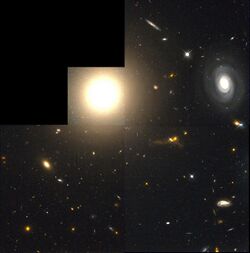Astronomy:NGC 4881
| NGC 4881 | |
|---|---|
 Elliptical Galaxy NGC 4881 (center) and the Spiral galaxy PGC 44691 (right). | |
| Observation data (J2000 epoch) | |
| Constellation | Coma Berenices |
| Right ascension | 12h 59m 57.74810s[1] |
| Declination | +28° 14′ 48.0093″[1] |
| Helio radial velocity | 6740±6 km/s[2] |
| Galactocentric velocity | 6755±6 km/s[2] |
| Distance | 308.61 ± 0.72 Mly (94.62 ± 0.22 Mpc)[3] |
| Apparent magnitude (V) | 14.6[2] |
| Characteristics | |
| Type | E0[4] |
| Apparent size (V) | 1′.0 × 1′.0[2] |
| Other designations | |
| NGC 4481, UGC 8106, PGC 44686[2][5] | |
NGC 4881 is an elliptical galaxy in the northern constellation of Coma Berenices. It was discovered by the German astronomer Heinrich Louis d'Arrest on April 22, 1865. John L. E. Dreyer described it as "faint, small, a little extended, 9th magnitude star to southwest".[6] This object is located at a distance of approximately 309 megalight-years from the Milky Way.[3] It is a member of the Coma cluster of galaxies,[7] positioned around 18′ to the north of the cluster's center with no nearby galactic neighbors.[4]
The morphological class of this galaxy is E0, indicating it is an elliptical galaxy with a spherically symmetric form. It does not display any unusual or peculiar features. A total of 88 globular cluster candidates have been identified orbiting this galaxy, which yields an estimated total of 195±21.[4] It has an unusually low frequency of globulars for a galaxy of this type.[8]
See also
- Mice Galaxies
- Virgo A
References
- ↑ 1.0 1.1 Brown, A. G. A. (August 2018). "Gaia Data Release 2: Summary of the contents and survey properties". Astronomy & Astrophysics 616: A1. doi:10.1051/0004-6361/201833051. Bibcode: 2018A&A...616A...1G. Gaia DR2 record for this source at VizieR.
- ↑ 2.0 2.1 2.2 2.3 2.4 "NASA/IPAC Extragalactic Database". Results for NGC 4881. http://ned.ipac.caltech.edu/cgi-bin/objsearch?objname=ngc4881&extend=no&hconst=73&omegam=0.27&omegav=0.73&corr_z=1&out_csys=Equatorial&out_equinox=J2000.0&obj_sort=RA+or+Longitude&of=pre_text&zv_breaker=30000.0&list_limit=5&img_stamp=YES.
- ↑ 3.0 3.1 Tully, R. Brent et al. (October 2013), "Cosmicflows-2: The Data", The Astronomical Journal 146 (4): 25, doi:10.1088/0004-6256/146/4/86, 86, Bibcode: 2013AJ....146...86T
- ↑ 4.0 4.1 4.2 Baum, W. A. et al. (December 1995). "Globular Clusters in Coma Galaxy NGC 4881". Astronomical Journal 110: 2537. doi:10.1086/117710. Bibcode: 1995AJ....110.2537B.
- ↑ "NGC 4881". SIMBAD. Centre de données astronomiques de Strasbourg. http://simbad.u-strasbg.fr/simbad/sim-basic?Ident=NGC+4881.
- ↑ Seligman, Courtney. "New General Catalogue objects: NGC 4850 - 4899". https://cseligman.com/text/atlas/ngc48a.htm#4881.
- ↑ Thomsen, Bjarne et al. (1997). "The Distance to the Coma Cluster from Surface Brightness Fluctuations". The Astrophysical Journal 483 (1): L37–L40. doi:10.1086/310735. ISSN 0004-637X. Bibcode: 1997ApJ...483L..37T.
- ↑ Baum, W. A.; Hammergren, M.; Light, R. M.; Ewald, S. P.; Groth, E. J.; Ajhar, E. A.; Lauer, T. R.; Lynds, C. R. et al. (December 1994). "Globulars to 27.6 Magnitude in the Coma Cluster". Bulletin of the American Astronomical Society 26: 1398. Bibcode: 1994AAS...185.5204B.
External links
- APOD: Elliptical Galaxy NGC 4881 in Coma (11/6/1996)
- HST: Galaxy NGC 4881 and the Coma cluster
- Coma Cluster at ESA/Hubble
 |

